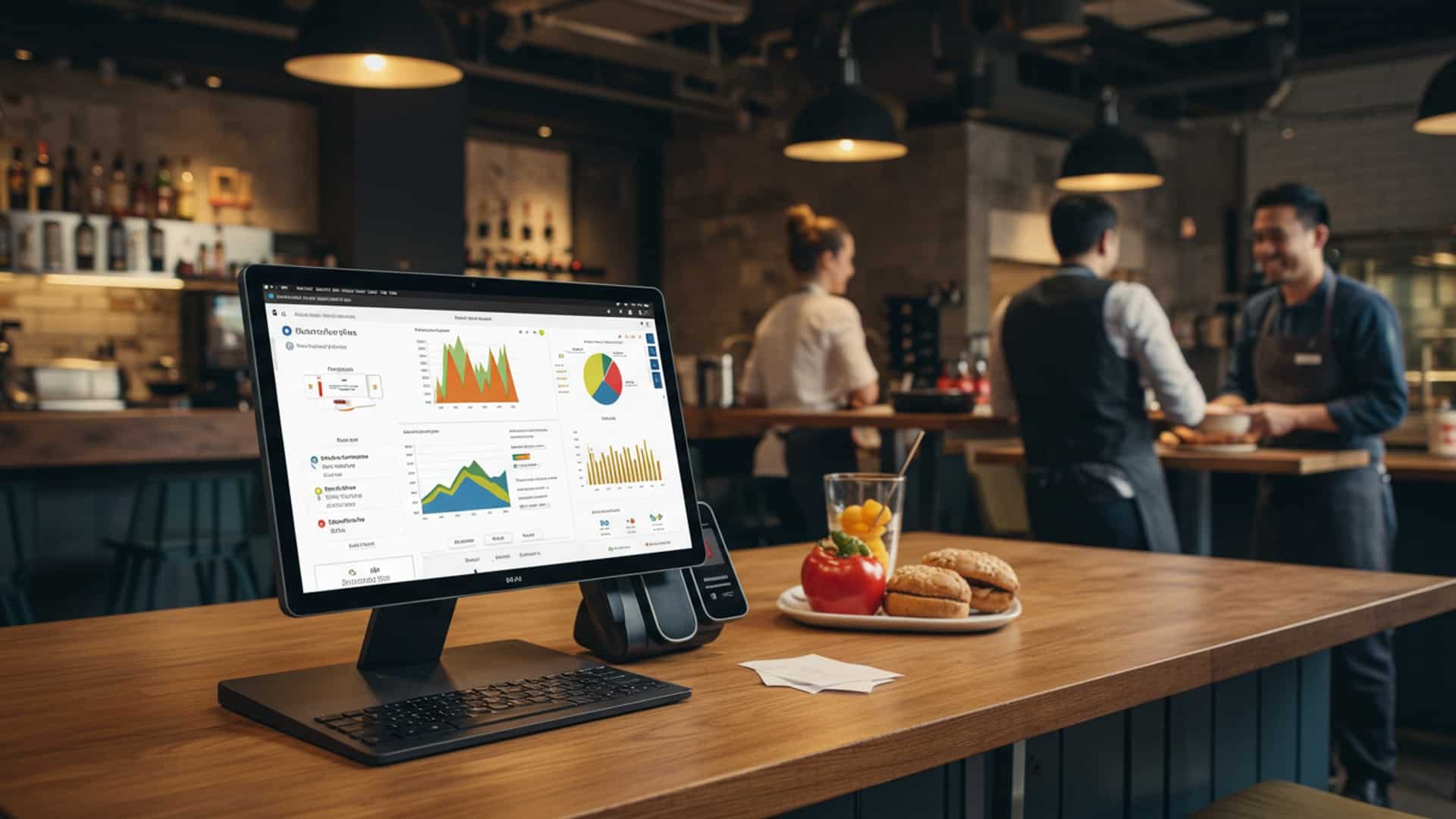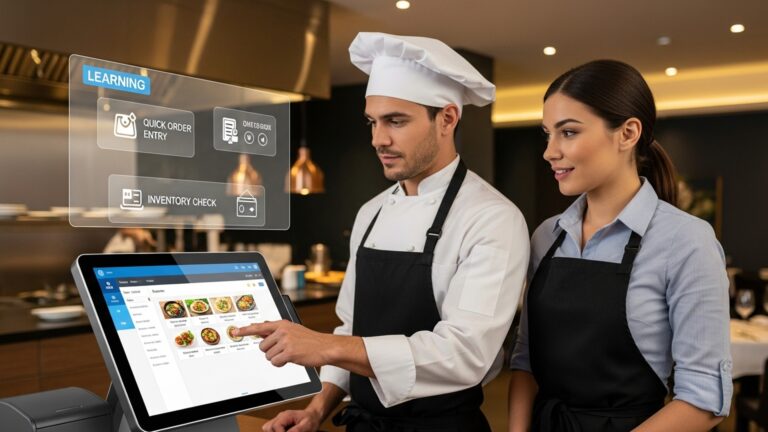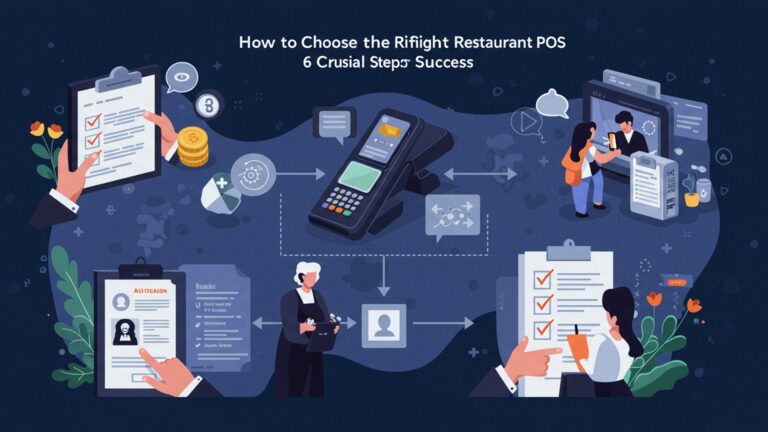Discover 7 Powerful Ways Restaurant POS Software Boosts Your Business
The modern restaurant operates at a blistering pace, navigating complex challenges from fluctuating food costs to the explosion of online delivery platforms. Relying on outdated systems means missing crucial opportunities to optimize, innovate. connect with today’s discerning diners. Forward-thinking establishments are now leveraging sophisticated restaurant POS software, transforming it from a mere transaction tool into a central nervous system for their entire operation. This integrated technology provides real-time insights into inventory, streamlines contactless ordering and payment. consolidates customer data across dine-in, takeout. delivery channels. By harnessing its capabilities, businesses gain unparalleled control over efficiency, profitability. the personalized guest experiences that define success in today’s competitive culinary world.

Revolutionizing Order Management and Accuracy
In the bustling environment of a restaurant, efficiency in order management is paramount. Historically, orders were taken manually, leading to potential miscommunications, lost tickets. slow service. But, modern Restaurant POS software has transformed this critical operational area, ensuring precision from the moment an order is placed until it reaches the customer.
A Point-of-Sale (POS) system centralizes all ordering functions. When a server inputs an order into a POS terminal – whether a fixed station, a handheld device, or a tablet – the data is immediately routed to the appropriate kitchen or bar station. This eliminates the need for handwritten tickets and verbal relaying, significantly reducing errors. For example, a common issue in traditional setups is illegible handwriting or misheard orders in a noisy kitchen. With Restaurant POS software, every item, modifier. special request is digitally recorded and displayed clearly.
Consider a busy Friday night: without a robust POS system, a server might manually write down a complex order for a table of six, including dietary restrictions and customizations. This ticket then needs to be physically delivered to the kitchen, where a chef might misinterpret an abbreviation or specification. With a modern POS, that same server inputs the order directly, perhaps even tableside using a portable device. The order for “Steak, medium-rare, no butter, side salad with vinaigrette instead of ranch” appears instantly and accurately on the kitchen display system (KDS), ensuring the kitchen staff prepares it exactly as requested. This not only speeds up service but also dramatically improves order accuracy, directly impacting customer satisfaction.
Actionable Takeaway: Invest in a Restaurant POS software that supports mobile ordering devices for servers. This allows for tableside ordering, sending orders directly to the kitchen. even processing payments right at the table, significantly cutting down on wait times and improving order precision.
Elevating the Customer Experience
Beyond just managing orders, advanced Restaurant POS software plays a pivotal role in enhancing the overall customer experience, fostering loyalty. driving repeat business. It moves the interaction beyond a transactional exchange, creating personalized and memorable visits.
One primary way POS systems achieve this is by speeding up service. From faster order processing to quicker payment options, customers appreciate efficiency, especially during peak hours. Moreover, many modern POS solutions integrate customer relationship management (CRM) functionalities. This allows restaurants to capture customer data, such as preferred dishes, dietary restrictions, visit frequency. even birthdays. This details can then be leveraged to offer personalized recommendations, special discounts, or even a complimentary dessert on their birthday, making customers feel valued and understood.
For instance, a coffee shop using Restaurant POS software can track a customer’s usual order – say, a “large latte with oat milk.” When that customer returns, the barista can greet them by name and even suggest their usual order, creating a highly personalized and efficient experience. Loyalty programs, a staple of customer retention, are also seamlessly managed by POS systems. Customers can earn points for every purchase, which can then be redeemed for rewards. This encourages repeat visits and builds a strong connection with the brand. A study by Bond Brand Loyalty found that 79% of consumers are more likely to spend money with a brand if they offer a loyalty program.
| Feature | Impact on Customer Experience |
|---|---|
| Mobile Ordering | Convenience, reduced wait times, order accuracy. |
| Loyalty Programs | Incentivizes repeat visits, builds brand affinity. |
| Customer Profiles | Personalized service, targeted promotions. |
| Diverse Payment Options | Flexibility, ease of transaction. |
Actionable Takeaway: Implement a loyalty program through your Restaurant POS software and actively encourage sign-ups. Use collected customer data to create targeted marketing campaigns and offer personalized experiences that make customers feel special.
Mastering Inventory and Supply Chain Efficiency
Food costs are one of the most significant expenses for any restaurant, making efficient inventory management crucial for profitability. Restaurant POS software provides powerful tools to track, manage. optimize inventory, drastically reducing waste and improving supply chain efficiency.
Unlike manual inventory counts, which are often sporadic and prone to human error, a POS system offers real-time inventory tracking. Every time an item is sold, the system automatically deducts the ingredients used from your stock. This allows managers to know exactly what they have on hand at any given moment, preventing both over-ordering (leading to spoilage) and under-ordering (leading to stockouts and lost sales). Many systems also allow for recipe management, where you input the exact quantities of ingredients for each menu item. This means when a “Burger Royale” is sold, the system automatically subtracts the patty, bun, cheese, lettuce, tomato. sauce components from your inventory.
Consider a busy pizzeria. Without a POS, tracking dough, cheese. pepperoni might involve daily manual checks. With integrated Restaurant POS software, as pizzas are sold, the system automatically adjusts ingredient levels. When the stock of pepperoni dips below a predefined reorder point, the system can even generate an automated purchase order to the supplier. This proactive approach ensures that essential ingredients are always available, minimizing emergency runs and ensuring consistent menu availability. One real-world example saw a small café reduce its weekly food waste by 20% within three months of implementing a comprehensive POS inventory module. This translated directly into significant cost savings and improved profit margins.
Actionable Takeaway: Utilize the inventory management features of your Restaurant POS software to set reorder points and automate purchase orders for frequently used items. Regularly reconcile physical inventory with POS data to identify discrepancies and minimize waste.
Unlocking Powerful Business Insights with Data Analytics
In today’s competitive restaurant landscape, making informed decisions is critical. Restaurant POS software isn’t just for processing transactions; it’s a goldmine of data, offering powerful analytics and reporting tools that provide invaluable insights into every aspect of your business’s performance.
These systems capture a wealth of details: sales by item, sales by hour, average check size, server performance, payment methods, popular times. much more. This data can be compiled into customizable reports that reveal trends, highlight strengths. pinpoint areas for improvement. For example, by analyzing sales reports, a restaurant owner can identify which menu items are best-sellers and which are underperforming. This allows for data-driven menu engineering – optimizing your menu to feature high-profit, popular items more prominently and potentially removing unpopular, low-margin dishes.
Let’s look at a practical application: a restaurant notices a dip in sales on Tuesdays. By drilling down into their Restaurant POS software analytics, they might discover that their most popular server isn’t scheduled on Tuesdays, or that specific, high-selling lunch items aren’t available due to ingredient shortages on that day. Armed with this knowledge, they can adjust staffing schedules or inventory replenishment to address the issue. Similarly, by analyzing peak hours, managers can optimize staffing levels, ensuring there are enough servers and kitchen staff during busy periods without overstaffing during slower times, thus controlling labor costs. Studies show that by Toast POS, restaurants using advanced analytics can see an average increase in profits of 5-10% by optimizing operations based on data.
Actionable Takeaway: Regularly review the sales and performance reports generated by your Restaurant POS software. Focus on identifying your top-performing menu items, peak service hours. individual staff performance to make strategic decisions on menu adjustments, staffing. marketing efforts.
Boosting Staff Productivity and Operational Flow
A smooth operation relies heavily on an efficient and productive staff. Restaurant POS software acts as a central nervous system for your team, streamlining tasks, improving communication. ultimately boosting overall productivity and operational flow.
One of the most immediate impacts is on order transmission. As mentioned, orders entered into the POS are instantly routed to the kitchen display system (KDS) or printer. This eliminates shouting orders, manual ticket handling. confusion, allowing kitchen staff to start preparing food immediately and servers to focus more on table service. Moreover, many POS systems include features like time clocks, allowing staff to clock in and out directly through the system. This simplifies payroll processing and ensures accurate tracking of labor hours, reducing administrative burdens for management.
Consider a scenario where a large party arrives. With traditional methods, coordinating multiple servers, managing individual checks. processing various payment types can be chaotic. With advanced Restaurant POS software, servers can easily split checks, transfer tables, or even collaborate on a single order from multiple devices. Managers can monitor sales performance in real-time, track individual server sales. identify who might need additional training or support. For instance, if a new server is consistently slow in taking orders, the manager can review their POS usage data to identify bottlenecks and provide targeted coaching. This level of insight allows for proactive staff management and continuous improvement in service delivery.
Actionable Takeaway: Leverage the staff management features within your Restaurant POS software, such as time tracking, sales performance tracking. role-based permissions. Use this data to identify training opportunities, optimize scheduling. empower your team with efficient tools.
Ensuring Secure and Diverse Payment Processing
In an age where digital transactions are the norm, secure and flexible payment processing is non-negotiable for restaurants. Restaurant POS software is at the forefront of this, offering a myriad of payment options while ensuring the highest level of security for both the business and its customers.
Modern POS systems integrate seamlessly with various payment processors, allowing restaurants to accept a wide range of payment methods. This includes traditional credit and debit cards (EMV chip cards), contactless payments (NFC like Apple Pay and Google Pay). even mobile payment apps. This diversity caters to customer preferences, making the checkout process faster and more convenient. Imagine a customer who prefers to pay with their phone; a POS system equipped for NFC payments allows for a quick tap-and-go transaction, enhancing their experience.
Beyond convenience, security is paramount. Restaurant POS software often comes with built-in features to ensure PCI DSS compliance, which is a set of security standards for organizations handling branded credit cards. It encrypts sensitive customer data during transactions, protecting against fraud and data breaches. For example, tokenization, a common security feature, replaces sensitive cardholder data with a unique, randomly generated “token” that cannot be reverse-engineered. This means that even if a system were breached, the stolen data would be useless to hackers. A real-world incident where a restaurant’s payment system was compromised led to thousands of credit card numbers being stolen. This highlights the critical importance of having a POS system with robust security features to protect both the business’s reputation and its customers’ financial insights.
Actionable Takeaway: Ensure your Restaurant POS software supports EMV and contactless payment options to meet customer expectations and enhance transaction security. Regularly update your POS system and payment terminals to comply with the latest PCI DSS standards and protect sensitive data.
Fortifying Security and Preventing Fraud
Beyond payment processing security, Restaurant POS software provides a comprehensive layer of protection against various forms of fraud, both internal and external. This is crucial for safeguarding a restaurant’s assets, maintaining financial integrity. ensuring a trustworthy operation.
One of the most significant benefits is the creation of a detailed audit trail for every transaction and action taken within the system. Every void, discount, refund. login is recorded, timestamped. associated with a specific employee. This level of transparency makes it incredibly difficult for employees to engage in fraudulent activities such as “sweethearting” (giving unauthorized discounts), skimming cash, or voiding orders after payment. For example, if an employee frequently voids high-value orders, the POS system’s reports will flag this anomaly, prompting management to investigate. Without a POS, tracking such incidents would be nearly impossible, leading to significant financial losses.
- Restaurant POS software
- Restaurant POS software
// Example of a simplified POS transaction log entry
{ "transaction_id": "TXN_87654321", "timestamp": "2023-10-27T14:35:00Z", "employee_id": "EMP_007", "action": "ORDER_VOIDED", "item_id": "SKU_BURGER_ROYALE", "quantity": 1, "reason": "Customer changed mind", "manager_override": "MGR_001", "original_amount": 14. 99
}
This kind of detailed logging provides irrefutable evidence for investigations and helps maintain accountability across the board.
Actionable Takeaway: Utilize the security features of your Restaurant POS software to its fullest extent. Implement strict user permissions, regularly review void and discount reports for suspicious activity. educate your staff on the importance of adhering to POS protocols to minimize fraud risks.
Conclusion
A modern restaurant POS is far more than just a transaction terminal; it’s the central nervous system that empowers your entire operation. To truly unlock its potential and move beyond basic order processing, I recommend actively leveraging its advanced analytics features. For instance, analyzing peak hour sales data through your POS, a crucial current trend, can reveal surprising menu insights, allowing you to optimize staffing and inventory like never before, a topic further explored in our guide on Mastering 10 Smart Ways Your Restaurant POS Can Boost Sales and Efficiency. Don’t just process orders; use the robust data available to make informed decisions that refine your customer experience and boost profitability. The future of dining is undeniably digital and data-driven, with your POS system at its forefront. Take the proactive step today to evaluate your current setup and explore how a truly integrated system can elevate your service, dramatically enhance efficiency. ultimately, secure a robust competitive edge. Remember, investing in smart POS technology isn’t merely an expense; it’s a strategic move towards sustainable success and unparalleled growth in today’s dynamic culinary landscape.
More Articles
Learn 7 Essential Restaurant POS Features to Improve Your Operations
Learn 8 Common Restaurant POS Software Mistakes and How to Avoid Them
5 Essential Tips to Choose the Best Restaurant POS Software System
How to Solve 6 Common Restaurant Problems with Smart POS Technology
FAQs
How can POS software really speed up my restaurant’s operations?
It streamlines everything from taking orders on tablets right at the table to sending them instantly to the kitchen display system (KDS). This cuts down on manual errors, gets food out faster. lets your staff focus more on guests instead of running back and forth.
Does POS software actually help me manage my ingredients better?
Absolutely! A good POS tracks every ingredient as it’s used in sales. This means you know exactly what you have, when to reorder. can even spot waste. No more guessing games or running out of popular items unexpectedly.
What kind of insights can I get about my sales with this software?
You get powerful reports that show you your best-selling dishes, busiest hours. even server performance. It’s like having a crystal ball for your business, helping you make smart decisions about your menu, staffing. promotions.
Can POS software help me keep my customers coming back?
Definitely! Many systems let you set up loyalty programs, track customer preferences. even send targeted promotions. You can create a more personalized experience, making your guests feel valued and encouraging them to return.
How does POS software handle online orders and delivery services?
Modern POS systems often integrate seamlessly with online ordering platforms and third-party delivery services. All orders, whether in-house or online, flow into one system, making it super easy to manage everything from a single screen and avoid missed orders.
Will using POS software actually save me money in the long run?
Yes, in many ways! By reducing food waste through better inventory, minimizing order errors, optimizing staff schedules. boosting overall efficiency, you’ll see a significant positive impact on your bottom line and profitability.
Is there anything in POS software that helps with my team?
Absolutely! Many systems include features for staff management like time clocks, shift scheduling. performance tracking. This helps you manage labor costs, ensure proper staffing levels. even identify top performers.






